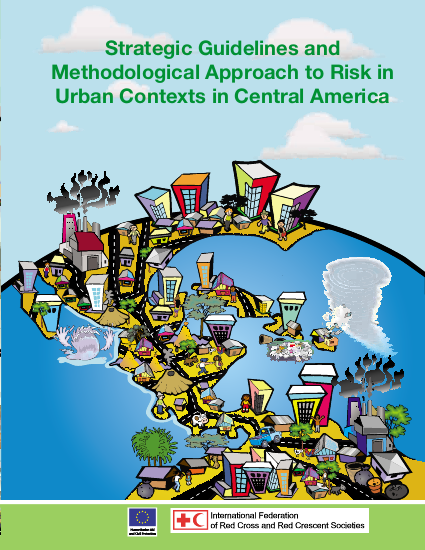
One of the aims of the International Federation of the Red Cross and Red Crescent Societies (IFRC), as stated in the Strategy 2020, is to strengthen community resilience as a means to reduce casualties and damages caused by disasters. The IFRC is implementing actions aimed specifically at urban contexts, as well as many other stakeholders working with humanitarian aid and development cooperation. Experience in recent years has shown that urban risk reduction strategies demand specific approaches which, in many cases, differ from the methodologies and tools proven to work in rural or semi-urban contexts. The reason is that urban —and more specifically, urban communities— have different dynamics and socioeconomic relationships.
There is much debate on the conceptual analysis of urban risk and how to address it in different contexts, especially since it is possible that the DIPECHO VII Regional Project will be implemented by the IFRC in Central America. This conceptual analysis has studied and discussed the basic aspects that impact the manifestation of risk and vulnerabilities of territories in cities, including the inseparable relationship between the urban and rural ecosystems, city/urban dynamics and entropies, sociocultural aspects in these spaces, human resource concentration, economic and financial activities, power relationships, and decision-making processes in large cities. Results and conclusions based upon these analyses have been published in a separate document.
Apparently, what differentiates risk in urban spaces is that it deals with a phenomenon that takes place in a group of social relationships related to production, distribution, and consumption set in an artificial, dynamic, integrated and dense scenario. Cities have high volumes of construction, population and vital lines; they are connected through multiple links which result in a different intensity in the risk construction process. This results in a unique risk typology for each urban conglomerate (some conclusions from the conceptual analysis document by Carlos Delgado Rodríguez). Throughout the different areas of inquiry that led to substantiate this workn1 there was consensus that the conceptual framework for risk being used and developed until now does not need changes to explain the urban risk category. Rather, it is agreed that the distinction between urban and non-urban risk is merely for clarification purposes and to determine the geographic location of the word. However, other elements that distinguish risk in urban spaces have been identified.
Undoubtedly, population density, with its extreme manifestation being precarious overcrowding, is one of the most relevant elements since it creates a high concentration of vulnerabilities in a small space. Geographically, city overcrowding levels are more relevant to the characterisation of its risk levels than to the total population size. Additionally, other elements identified include power relationships, decision-making capabilities, intense commercial and productive relationships, and the presence of institutional stakeholders and of the civil society impacting the generation —or reduction— of risk in cities and urban zones. The IFRC was particularly interested in the extensive debate that resulted from the topic of community and urban culture, where it was stated that certain social capacities inherent to rural areas, such as solidarity, sense of ownership, interpersonal and community relationships, are not as visible in urban territories.
One of the main conclusions from these spaces of collective thinking is that urban risk requires an approach different to the non-urban approach; that strategy design and implementation, programmes and projects have to vary depending on the urban context, and that there is need for extensive revision of current risk reduction tools and methodologies if they are to be effectively implemented in these contexts. In-depth discussion and consensus on the approach and strategic guidelines to be adopted when dealing with urban risk reduction are included in the following complementary analysis to the theoretical-conceptual analysis. When compiling the outcome of the conceptual, strategic and methodological analyses, the proposal seeks to change the expression urban risk to ‘risk in urban spaces’ or ‘risk in urban environments.’ This change will clarify and limit risk to specific urban territories. In order to better understand the strategic guidelines, this analysis begins by describing the main risk-generating factors and includes lessons learned and considerations from the most recent urban interventions in Central America.
Resource collections
- Evaluating humanitarian action
- UN Habitat - Urban Response Collection
- Urban Response - Urban Crisis Preparedness and Risk Reduction
- Urban Response Collection - Community Engagement and Social Cohesion
- Urban Response Collection - Economic Recovery
- Urban Response Collection - Environment and Climate Change
- Urban Response Collection - Housing, Land and Property
- Urban Response Collection - Urban Crisis Response, Recovery and Reconstruction
- Urban Response Collection - Urban Resilience